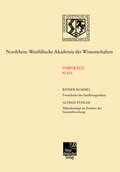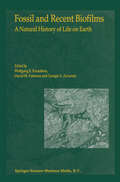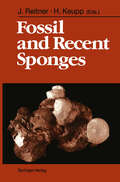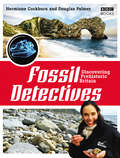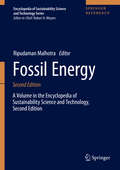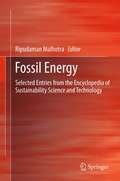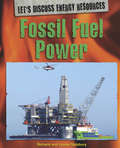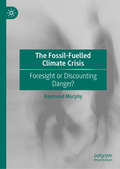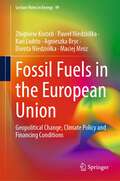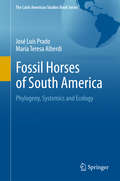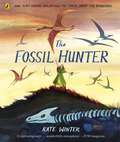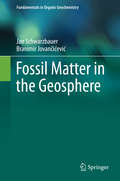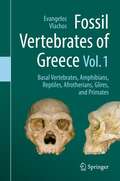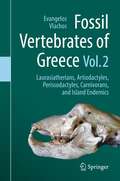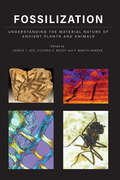- Table View
- List View
Fortschritte der Geodäsie: 317. Sitzung am 3. Oktober 1984 in Düsseldorf (Rheinisch-Westfälische Akademie der Wissenschaften #388)
by Helmut WolfFortschritte der Satellitengeodäsie. Mikrobiologie im Zeitalter der Genomforschung (Nordrhein-Westfälische Akademie der Wissenschaften #453)
by Reiner RummelFossil and Recent Biofilms: A Natural History of Life on Earth
by W. E. Krumbein D. M. Paterson G. A. ZavarzinMICROBIAL BIOFILMS: PROTECTIVE NICHES IN ANCIENT AND MODERN GEOMICROBIOLOGY J. W. Costerton and Paul Stoodley Center for Biofilm Engineering Montana State University As this book is published based on discussions of a conference that was held in 2001, it may be useful to provide an update on the most recent revelations about biofilms, so that this excellent exposition of the contribution of microbial biofilms to geological processes may be placed in a modem context. The importance of the contribution of microbial biofilms to global processes is only now being appreciated as it is revealed that all terrestrial surfaces are teeming with microbial life in the form of biofilm communities. These communities live on soil particles, in rock fissures, marine and river sediments and at the very extremes of terrestrial habitats from inside Antarctic ice to the walls of deep sea hydrothermal vents. The contribution of these biofilm communities generally went unrecognized because it was the water that was where microbiologists looked for life, not the surfaces, although, evidence of the early association of microbes with surfaces was in fact present in the fossil record (Rasmussen, 2000; Reysenbach, and Cady, 2001). It is also revealing that biofilm formation is found in prokaryotes from the most deeply rooted branches of the phylogenetic tree in both the Archaea and Bacteria kingdoms, the Korarchaeota and Aquificales respectively (Jahnke et al. 2001; Reysenbach et al. 2000).
The Fossil Detectives: Discovering Prehistoric Britain
by Douglas Palmer Hermione CockburnFossils provide us with a tantalizing glimpse of Britain's prehistoric past and hold the key to unlocking the secrets of life's history and evolution. Since the appearance of primitive organisms in Britain more than a billion years ago, oceans, deserts, swamps and vast mountains have come and gone in our corner of western Europe; forests of long-extinct trees, flowers and grasses have covered the land, and dinosaurs and other strange creatures have roamed across it. How do we know? The evidence is all around us - in the rocks and fossils that lie beneath the landscape.In this highly informative and practical book, which accompanies the BBC series, presenter Hermione Cockburn and renowned palaeontologist Douglas Palmer take an in-depth look at the most exciting fossil stories from around the country. When and why were dinosaur fossils first discovered in Britain? How was the biggest fish ever to have swum in the sea unearthed near Peterborough? What do modern medical techniques have to offer fossil hunters?Packed with colour photographs and illustrations, Fossils Detectives is full of surprising facts and features. And for those who want to try their hand at some fossil detecting of their own, the book includes an extensive regional gazetteer of fossil-hunting sites and places to visit, and guidance on identifying your fossil finds.Get ready for some time travel around Britain, with the Fossil Detectives!
Fossil Earthquakes: The Formation and Preservation of Pseudotachylytes (Lecture Notes in Earth Sciences #111)
by Aiming LinThis book focuses on the earthquake source materials produced or deformed by both seismic faulting and aseismic creep within seismogenic fault zones at different levels of the crust. In particular, the mechanisms and processes involved in the formation of earthquake materials are covered. The book is intended to help bridge the gap between seismology and geology and to encourage further studies of earthquake mechanisms and seismic faulting processes.
Fossil Energy: Selected Entries From The Encyclopedia Of Sustainability Science And Technology (Encyclopedia Of Sustainability Science And Technology Ser.)
by Ripudaman MalhotraFossil Energy: Selected Entries from the Encyclopedia of Sustainability Science and Technology (Encyclopedia Of Sustainability Science And Technology Ser.)
by Ripudaman MalhotraThe word sustainability shares its root with sustenance. In the context of modern society, sustenance is inextricably linked to the use of energy. Fossil Energy provides an authoritative reference on all aspects of this key resource, which currently represents nearly 85% of global energy consumption. Gathering 16 peer-reviewed entries from the Encyclopedia of Sustainability Science and Technology, the chapters provide comprehensive, yet concise coverage of fundamentals and current areas of research. Written by recognized authorities in the field, this volume represents an essential resource for scientists and engineers working on the development of energy resources, fossil or alternative, and reflects the essential role of energy supplies in supporting a sustainable future.
Fossil Fuel Power: Fossil Fuel Power Library Ebook (Let's Discuss Energy Resources #4)
by Richard Spilsbury Louise SpilsburyWith supplies of non-renewable energy sources running low and the threat of global warming and climate change, there is an urgent need to look at other types of energy resources and how well they can meet our power needs. While new technologies are being developed, each energy resource comes at a cost. This series looks at each energy resource, the technology and cost of how it is used to meet power needs and how it impacts the environment and humans. Each book explains how that power is generated and where it is used, and then, using specific Let's Discuss panels, explores the various advantages and disadvantages that concern it's use as an alternative fuel source. Case studies examine specific usage examples where that source has either worked or not worked so that the reader can weigh up the pros and cons for the use of each source against the alternatives.
Fossil fuel power station (large print)
by RnibThis is a labelled cross section diagram of a fossil fuel power station, showing the process of producing electrical power from fossil fuels such coal, coke, gas and oil, and also wood and bio fuels (oils and gases from plant sources). There is a locator dot shown, which will be at the top left of the page when the image is the correct way up. The image is surrounded by a dashed line image border. The diagram is in four main sections. From left to right these are: the boiler, the steam turbine, the generator and the cooling tower. The fuel comes into the boiler on the left of the page through a pipe and is burnt to create a high temperature inside the boiler. To the right is the steam turbine. A pipe carries water from the bottom of the turbine enclosure to the left, into a heat exchanger in the boiler, where it is heated to create steam at high pressure. This travels to the right through a pipe to rotate the turbine blades at high speed. To the right, a generator, driven by the rotation of the turbine produces an alternating electric current, which is fed into the national electricity grid. To the right of the generator you can find a cooling tower. Hot water from a condenser in the turbine housing is pumped to water jets in the cooling tower and sprayed into a tank to cool. The cold water is then pumped back to the condenser in the turbine housing to condense the steam from the turbine.
Fossil fuel power station (UEB contracted)
by RnibThis is a labelled cross section diagram of a fossil fuel power station, showing the process of producing electrical power from fossil fuels such coal, coke, gas and oil, and also wood and bio fuels (oils and gases from plant sources). There is a locator dot shown, which will be at the top left of the page when the image is the correct way up. The image is surrounded by a dashed line image border. The diagram is in four main sections. From left to right these are: the boiler, the steam turbine, the generator and the cooling tower. The fuel comes into the boiler on the left of the page through a pipe and is burnt to create a high temperature inside the boiler. To the right is the steam turbine. A pipe carries water from the bottom of the turbine enclosure to the left, into a heat exchanger in the boiler, where it is heated to create steam at high pressure. This travels to the right through a pipe to rotate the turbine blades at high speed. To the right, a generator, driven by the rotation of the turbine produces an alternating electric current, which is fed into the national electricity grid. To the right of the generator you can find a cooling tower. Hot water from a condenser in the turbine housing is pumped to water jets in the cooling tower and sprayed into a tank to cool. The cold water is then pumped back to the condenser in the turbine housing to condense the steam from the turbine.
Fossil fuel power station (UEB uncontracted)
by RnibThis is a labelled cross section diagram of a fossil fuel power station, showing the process of producing electrical power from fossil fuels such coal, coke, gas and oil, and also wood and bio fuels (oils and gases from plant sources). There is a locator dot shown, which will be at the top left of the page when the image is the correct way up. The image is surrounded by a dashed line image border. The diagram is in four main sections. From left to right these are: the boiler, the steam turbine, the generator and the cooling tower. The fuel comes into the boiler on the left of the page through a pipe and is burnt to create a high temperature inside the boiler. To the right is the steam turbine. A pipe carries water from the bottom of the turbine enclosure to the left, into a heat exchanger in the boiler, where it is heated to create steam at high pressure. This travels to the right through a pipe to rotate the turbine blades at high speed. To the right, a generator, driven by the rotation of the turbine produces an alternating electric current, which is fed into the national electricity grid. To the right of the generator you can find a cooling tower. Hot water from a condenser in the turbine housing is pumped to water jets in the cooling tower and sprayed into a tank to cool. The cold water is then pumped back to the condenser in the turbine housing to condense the steam from the turbine.
Fossil Fuel Subsidy Reforms: A Guide to Economic and Political Complexity (Routledge Studies in Energy Policy)
by Jun RentschlerCountries around the world are spending up to $500 billion per year on subsidising fossil fuel consumption. By some estimates, the G20 countries alone are spending around another $450 billion on subsidising fossil fuel production. In addition, the indirect social welfare costs of these subsidies have been shown to be substantial – for instance due to air pollution, road congestion, climate change, and economic inefficiency, to name a few. Considering these numbers, there is no doubt that fossil fuel subsidies cause severe economic distortions that compromise countries’ prospects of achieving equitable and sustainable development. This book provides a guide to the complex challenge of designing, assessing, and implementing effective fossil fuel subsidy reforms. It shows that subsidy reform requires a careful balancing of complex economic and political trade-offs, as well as measures to mitigate adverse effects on vulnerable households and to assist firms with implementing efficiency enhancing measures. Going beyond the purely fiscal perspective, this book emphasises that smart subsidy reforms can contribute to all three dimensions of sustainable development – environment, society, and economy. Over the course of eight chapters, this book considers a wide range of agents and stakeholders, markets, and policy measures in order to distil the key principles of designing effective fossil fuel subsidy reforms. This book will be of great relevance to scholars and policy makers with an interest in energy economics and policy, climate change policy, and sustainable development more broadly.
Fossil Fuel Subsidy Reforms: A Guide to Economic and Political Complexity (Routledge Studies in Energy Policy)
by Jun RentschlerCountries around the world are spending up to $500 billion per year on subsidising fossil fuel consumption. By some estimates, the G20 countries alone are spending around another $450 billion on subsidising fossil fuel production. In addition, the indirect social welfare costs of these subsidies have been shown to be substantial – for instance due to air pollution, road congestion, climate change, and economic inefficiency, to name a few. Considering these numbers, there is no doubt that fossil fuel subsidies cause severe economic distortions that compromise countries’ prospects of achieving equitable and sustainable development. This book provides a guide to the complex challenge of designing, assessing, and implementing effective fossil fuel subsidy reforms. It shows that subsidy reform requires a careful balancing of complex economic and political trade-offs, as well as measures to mitigate adverse effects on vulnerable households and to assist firms with implementing efficiency enhancing measures. Going beyond the purely fiscal perspective, this book emphasises that smart subsidy reforms can contribute to all three dimensions of sustainable development – environment, society, and economy. Over the course of eight chapters, this book considers a wide range of agents and stakeholders, markets, and policy measures in order to distil the key principles of designing effective fossil fuel subsidy reforms. This book will be of great relevance to scholars and policy makers with an interest in energy economics and policy, climate change policy, and sustainable development more broadly.
The Fossil-Fuelled Climate Crisis: Foresight or Discounting Danger?
by Raymond MurphyThis book analyses the threat posed by the continued use of fossil fuels. By utilizing Elizabeth Shove’s social practices approach and Murphy’s own social closure framework, the book examines the accelerating treadmill of carbon-polluting practices. It incorporates externalities theory to investigate how the full cost of fossil fuels is paid by others rather than users, and to demonstrate that the environmental commons is a medium for conveying intergenerational monopolisation and exclusion in the Anthropocene. Murphy uncovers a pattern of opposition to change when exploiting valuable but dangerous resources. He argues that a new faith in mastering nature is emerging as a belief in just-in-time technological solutions to circumvent having to change fossil-fuelled practices.The book then moves on to assess proposed solutions, including Beck’s staging of risk and his hypothesis that the anticipation of global catastrophe will incite emancipation. It proposes a novel approach to enhancing foresight and avoid incubating disaster. It will appeal to readers interested in an original social science analysis of this creeping crisis and its resolution.
Fossil Fuels in the European Union: Geopolitical Change, Climate Policy and Financing Conditions (Lecture Notes in Energy #99)
by Zbigniew Korzeb Paweł Niedziółka Kari Liuhto Agnieszka Bryc Dorota Niedziółka Maciej MrózThis book identifies scenarios for changes in transmission infrastructure, contracting, consumption patterns and fossil fuel financing policies, considering climate goals and the consequences of the conflict in Ukraine. The invasion of Ukraine by the Russian Federation has fundamentally changed the geopolitical situation, approaches to energy security issues, the EU’s energy (in)dependence and the implementation of previously outlined climate policies, including the planned gradual withdrawal from fossil fuels.This book presents the geopolitical architecture, energy mix, energy fuel supply structure, long-term energy policy and financing conditions of the oil and gas and sectors in the EU in the period preceding and following the Russian invasion of Ukraine. The authors consider the date of Russia’s attack on Ukraine as a symbolic caesura marking the beginning of the process of creating a new energy order in the EU. A novel part of the book is the attention it pays to the role of the credit and investment policy of the EU banking sector in relation to carbon-intensive sectors and to the significance of the financial system from the point of view of the effectiveness of international sanctions imposed on the Russian Federation, including, above all, sanctions related to the fossil fuel sector. The book is of interest to researchers and all those interested in learning about these subjects.
Fossil Horses of South America: Phylogeny, Systemics and Ecology (The Latin American Studies Book Series)
by José Luis Prado María Teresa AlberdiThis book provides an update on the phylogeny, systematics and ecology of horses in South America based on data provided over the past three decades. The contemporary South American mammalian communities were shaped by the emergence of the Isthmus of Panama and by the profound climatic oscillations during the Pleistocene. Horses were a conspicuous group of immigrant mammals from North America that arrived in South America during the Pleistocene. This group is represented by 2 genera, Hippidion and Equus, which include small species (Hippidion devillei, H. saldiasi, E. andium and E. insulatus) and large forms (Equus neogeus and H. principale). Both groups arrived in South America via 2 different routes. One model designed to explain this migration indicates that the small forms used the Andes corridor, while larger horses used the eastern route and arrived through some coastal areas. Molecular dating (ancient DNA) suggests that the South American horses separated from the North American taxa (caballines and the New World stilt-legged horse) after 3.6 - 3.2 Ma, consistent with the final formation of the Panamanian Isthmus. Recent studies of stable isotopes in these horses indicate an extensive range of 13C values cover closed woodlands to C4 grasslands. This plasticity agrees with the hypothesis that generalist species and open biome specialist species from North America indicate a positive migration through South America.
The Fossil Hunter: How Mary Anning unearthed the truth about the dinosaurs
by Kate WinterUnearth the mysteries of ancient fossils and discover the life and legacy of Mary Anning in this beautifully illustrated, fact-filled book for curious young readers.Have you ever found something mysterious? Something where you had no idea what it was but you had this feeling it was important, that it held a secret?Mary Anning was a fossil hunter, scouring the cliffs and seashores of Lyme Regis for strange rocks and shells. Monstrous marine reptiles and dinosaurs had once reigned the land and seas here millions of years ago, disappearing only to leave mysterious traces for humans to puzzle over.Mary's fossils paved the way for modern palaeontology and helped to piece together a picture of how the dinosaurs lived and evolved. Little did she know that 200 years later we would still be talking about her amazing discoveries and how she influenced our understanding of the history of the earth.Beautifully illustrated by brand-new talent Kate Winter, with stunning panoramic fold-out pages, this is a book to treasure and to read again and again, perfect for all fans of natural history and curious young explorers.'A captivating story [...] wonderfully atmospheric' - JUNO magazine
Fossil Matter in the Geosphere (Fundamentals in Organic Geochemistry)
by Jan Schwarzbauer Branimir JovančićevićThe first volume in this new text book series covers comprehensively relevant aspects related to the appearance and characterisation of fossil matter in the geosphere such as kerogen, oil, shales and coals. As organic geochemistry is a modern scientific subject characterized by a high transdisciplinarity and located at the edge of chemistry, environmental sciences, geology and biology, there clearly is a need for a flexible offer of appropriate academic teaching material on an undergraduat level addressed to the variety of students coming originally from different study disciplines. For such a flexible usage this textbook series' consists of different volumes with clear defined aspects and with manageable length.
Fossil Vertebrates of Greece Vol. 1: Basal vertebrates, Amphibians, Reptiles, Afrotherians, Glires, and Primates
by Evangelos VlachosThis 2-volume set provides a state-of-the-art study of the fossil record and taxonomy of the main vertebrate groups from Greece. Greece stands between 3 continents and its vertebrate fossil record is of great importance for paleontological and evolutionary studies in Europe, Asia and Africa. Fossils from classic, world-famous localities (e.g., Pikermi, Samos) form an essential part of the collections of the most important museums in the world and have been studied by numerous scientists. Recent paleontological research led to the discovery and study of numerous new sites. The volumes contain a taxonomic review of all named and identified taxa, their taxonomic history and current status, as well as historical, phylogenetic and biogeographic information. Volume 1 contains a synopsis of the fossil record and taxonomy of important groups of vertebrates represented in the fossil record of Greece. The volume deals with some of the early splitting clades, including the basal and enigmatic conodonts and basal tetrapods like fishes, amphibians, and reptiles like lizards, snakes, crocodiles, turtles and tortoises. The second part of the volume deals with basal mammalian clades, some of which are quite characteristic for the fossil record of the country: aardwarks, hyraxes, proboscideans, elephants and mammoths, sea cows, rodents, and lagomorphs. The volume ends with special chapters on the primate fossil record of the country, including some of our most recent and distant relatives.
Fossil Vertebrates of Greece Vol. 2: Laurasiatherians, Artiodactyles, Perissodactyles, Carnivorans, and Island Endemics
by Evangelos VlachosThis 2-volume set provides a state-of-the-art study of the fossil record and taxonomy of the main vertebrate groups from Greece. Greece stands between 3 continents and its vertebrate fossil record is of great importance for paleontological and evolutionary studies in Europe, Asia and Africa. Fossils from classic, world-famous localities (e.g., Pikermi, Samos) form an essential part of the collections of the most important museums in the world and have been studied by numerous scientists. Recent paleontological research led to the discovery and study of numerous new sites. The volumes contain a taxonomic review of all named and identified taxa, their taxonomic history and current status, as well as historical, phylogenetic and biogeographic information. Volume 2 contains a synopsis of the fossil record and taxonomy of important groups of mammals represented in the fossil record of Greece. The volume starts with specific chapters on laurasiatherians like insectivores and bats, moving on to the main part of the book that deals with three of the most important fossil groups in the country. The fossil record of even-toed animals is summarized with chapters on bovids, cervids, suoids, anthracotheres, hippos, giraffes, and tragulids. The fossil record of odd-toed animals is presented with special chapters on horses, tapirs, rhinos, and chalicotheres. The last part of this volume deals with meat-eating, carnivoran groups, like felids, viverrids, hyaenas, canids, bears, ailurids, mephitids and mustelids. The volume ends with a special chapter on insular endemic mammals from the various islands of Greece.
Fossilization: Understanding the Material Nature of Ancient Plants and Animals
by Carole T. Gee, Victoria E. McCoy, and P. Martin SanderUnderstanding the complex interplay of physical and chemical processes leading to fossilization is crucial to elucidating the 3800 million years of life on earth. And yet, the process of fossilization also leads to the loss of pivotal biological information, placing constraints on the very same understanding of ancient life it preserves. Over the last decade, however, remarkable advances in approaches, techniques, tools, and instrumentation have helped scientists to transcend these constraints by enabling high-resolution analysis of fossil material—even down to the nanoscale. Fossilization provides a critical look at these cutting-edge innovations in the science of fossil preservation and provides a road map for future research. Drawing from the fields of paleontology, organic and inorganic chemistry, microbiology, and high-resolution imaging and analysis, and spanning the diversity of life from plants to vertebrates and invertebrates, this resource details expert findings on• fossilization of hard and soft part tissues in dinosaurs• high-resolution chemical analysis of organic and inorganic tissues• arthropods preserved in amber• experimental silicification of wood• chemical defenses and color in fossil plants • confocal Raman spectroscopy• microprobe analysis• radioisotopic studies• and much moreA true interdisciplinary undertaking, the book is authored by paleontologists, mineralogists, geochemists, organic chemists, microbiologists, and materials scientists who have worked together to investigate questions around substance fossilization and the limits of the fossil record. A special color section contains SEM, Raman, and other striking images of vertebrates, invertebrates, and plants. Fossilization is a trailblazing reference book for research scientists and specialists in related fields, as well as for advanced undergraduates and graduate students interested in fossilization, emerging research techniques, and fresh approaches in the analysis of plant and animal fossils.Contributors: H. Jonas Barthel, Aurore Canoville, Carole T. Gee, Thorsten Geisler, Jens Götze, Conrad C. Labandeira, Sashima Läbe, Moritz Liesegang, Victoria E. McCoy, Martina Menneken, Jes Rust, P. Martin Sander, Frank Tomaschek, Torsten Wappler, Kayleigh Wiersma, Tzu-Ruei Yang
Fossilization: Understanding the Material Nature of Ancient Plants and Animals
by Carole T. Gee Victoria E. McCoy P. Martin SanderUnderstanding the complex interplay of physical and chemical processes leading to fossilization is crucial to elucidating the 3800 million years of life on earth. And yet, the process of fossilization also leads to the loss of pivotal biological information, placing constraints on the very same understanding of ancient life it preserves. Over the last decade, however, remarkable advances in approaches, techniques, tools, and instrumentation have helped scientists to transcend these constraints by enabling high-resolution analysis of fossil material—even down to the nanoscale. Fossilization provides a critical look at these cutting-edge innovations in the science of fossil preservation and provides a road map for future research. Drawing from the fields of paleontology, organic and inorganic chemistry, microbiology, and high-resolution imaging and analysis, and spanning the diversity of life from plants to vertebrates and invertebrates, this resource details expert findings on• fossilization of hard and soft part tissues in dinosaurs• high-resolution chemical analysis of organic and inorganic tissues• arthropods preserved in amber• experimental silicification of wood• chemical defenses and color in fossil plants • confocal Raman spectroscopy• microprobe analysis• radioisotopic studies• and much moreA true interdisciplinary undertaking, the book is authored by paleontologists, mineralogists, geochemists, organic chemists, microbiologists, and materials scientists who have worked together to investigate questions around substance fossilization and the limits of the fossil record. A special color section contains SEM, Raman, and other striking images of vertebrates, invertebrates, and plants. Fossilization is a trailblazing reference book for research scientists and specialists in related fields, as well as for advanced undergraduates and graduate students interested in fossilization, emerging research techniques, and fresh approaches in the analysis of plant and animal fossils.Contributors: H. Jonas Barthel, Aurore Canoville, Carole T. Gee, Thorsten Geisler, Jens Götze, Conrad C. Labandeira, Sashima Läbe, Moritz Liesegang, Victoria E. McCoy, Martina Menneken, Jes Rust, P. Martin Sander, Frank Tomaschek, Torsten Wappler, Kayleigh Wiersma, Tzu-Ruei Yang
Fossils at a Glance
by Clare Milsom Sue RigbyFossils provide a powerful tool for the study of the nearly 4-billion-year history of life, and its role in the evolution of Earth systems. They also provide important data for evolutionary studies, and contribute to our understanding of the extinction of organisms and the origins of modern biodiversity. Fossils At A Glance is written for students taking an introductory level course in paleontology. Short chapters introduce the main topics in the modern study of fossils. The most important fossil groups are discussed, from microfossils through invertebrates to vertebrates and plants, followed by a brief narrative of life on Earth. Diagrams are central to the book and allow the reader to see most of the important data “at a glance”. Each topic covers two pages and provides a self-contained suite of information or a starting point for future study. This second edition has been thoroughly revised and brought up to date. It includes new line diagrams as well as photographs of selected fossils

